What Happens When You Put a Plastic Vapor Barrier in Your Wall?
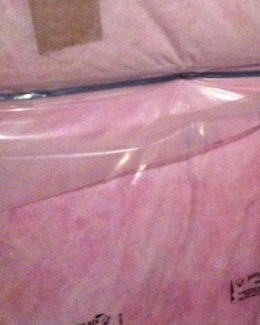
A lot of people have heard advice about vapor barriers and vapor retarders. Many of them have walked away confused. A big part of the problem, I think, is that they’ve been told what to do—”Put it on the warm-in-winter side,” or “Never use one”—but they haven’t had the physics of what happens explained to them.
In this article, I’m not going to get into the details of vapor barriers or all the possible scenarios of different wall assemblies and moisture loads. I’m simply going to explain what happens in a wall cavity with and without a plastic vapor barrier installed.
Plastic on the inside
1. Hot Humid Weather
I’m writing this article because one of our HERS raters came across a house in Charleston, SC that had poly under the drywall, on the interior side of the wall assembly. If you’re at all familiar with the climate in Charleston and understand moisture, you know that can’t be a good thing.
I was there one day in June a few years ago and saw condensation on the outside of a window…at 1 o’clock in the afternoon of a sunny day. The dew point of the outdoor air was 78° F. The window had a single pane of glass. They were running the air conditioner, so the indoor temperature was probably 75 or below. Humid air hits cool surface. Condensation results.
Now, imagine that pane of glass is actually a sheet of polyethylene. Next, imagine that a layer of drywall separates the poly from the indoor air. Then build a wood-frame wall outside the poly, complete with cladding and air permeable insulation in the cavities. Will that poly be protected from the outdoor humidity? Or will it, like the window I saw, be dripping with condensation?
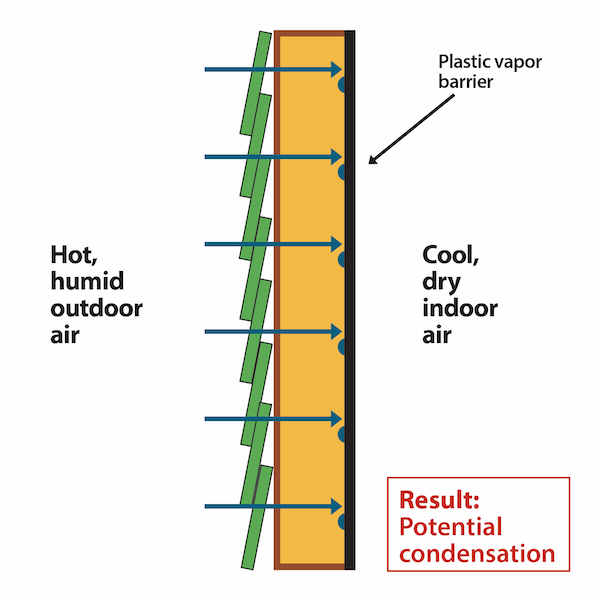
If it’s a typical wall, chances are good that water vapor in the outdoor air will find its way into the wall cavity, eventually finding the sheet of poly, pressed up against the drywall. If that wall allows outdoor air to infiltrate and the poly is below the dew point, condensation is the likely result. If those conditions last long enough, the condensed water will run down the poly, get the wood framing wet, and begin to rot out the wall.
The truth, though, is that the water vapor in the outdoor air is rarely the source of moisture that rots out a wall. More likely is that moisture from a wet foundation makes its way up into the wall by capillary action, or bulk water from leaks around openings gets into the wall cavity. The presence of an interior vapor barrier makes drying out the cavity harder to do, though.
Without poly beneath the drywall, water vapor hits the drywall and diffuses through to the drier (in summer) indoor air. By installing a sheet of poly there, you cut off that drying mechanism and water that finds its way into walls can stay there longer and do more damage.
2. Cold Weather
In cold weather, a sheet of poly on the interior side of a wall probably won’t cause any problems. The humid air is indoors, and the dry air is outdoors. The sheet of poly still cuts off drying to the indoors, but it keeps the water vapor in the humid indoor air away from the cold surfaces inside the wall. This is what building scientists proposed as the solution for walls that wouldn’t hold paint back in the early days of insulation. It didn’t solve the paint problem, though, because water vapor from the indoor air wasn’t the main source of moisture.
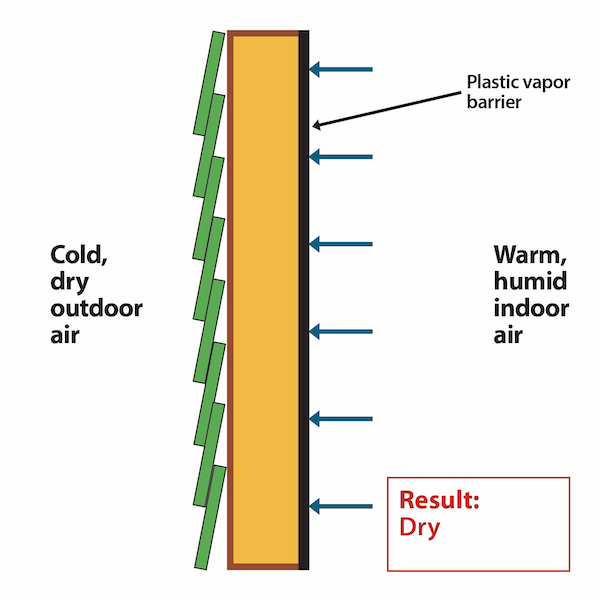
Plastic on the outside
3. Cold Weather
Plastic on the outer surface of a wall in cold weather could cause problems. The humid air is indoors. The cool surface is the sheathing, assuming no exterior insulation. If water vapor diffuses or infiltrates into the wall cavity and finds the cool surface, moisture problems can occur.
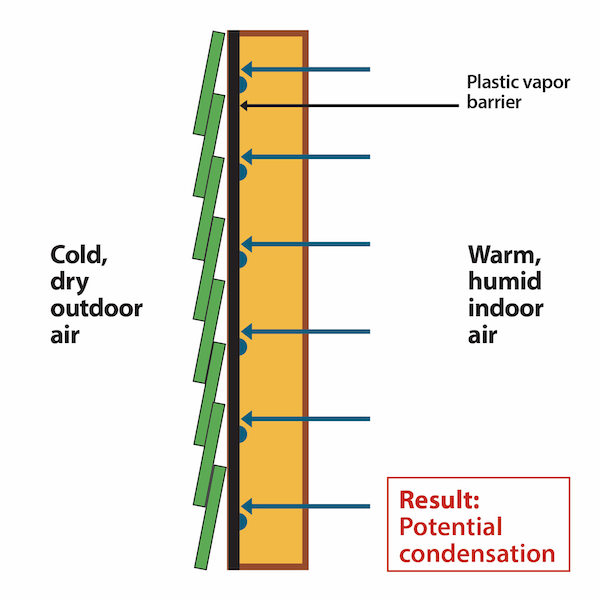
Of course, you can have moisture problems here even without the exterior vapor barrier because of what Bill Rose calls the rule of material wetting. That is, warm materials dry more quickly than cold materials.
4. Hot Humid Weather
The problem occurs with a vapor barrier when it prevents drying to the drier space. In a building with air conditioning during hot humid weather, the drier space is indoors. The humid air is outdoors. The wrong place to put a vapor barrier is on the inside because any humid air that gets into the wall cavity is blocked from drying to the inside.
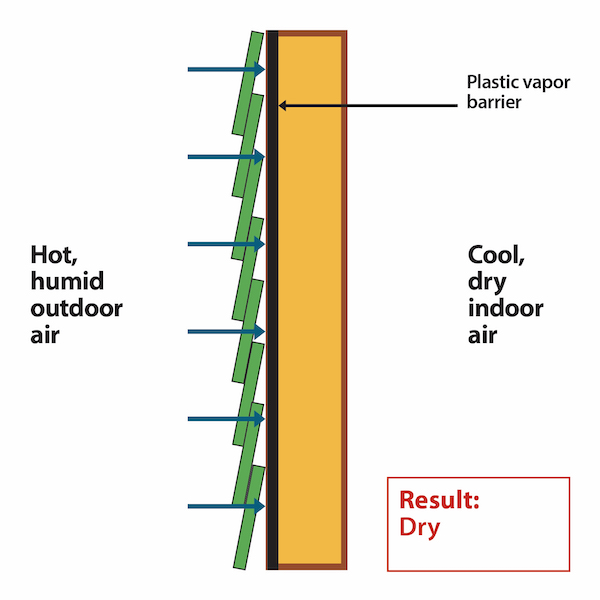
If the vapor barrier is on the outside, it prevents the humid air from diffusing into the wall cavity and finding the cold surface on the other side of the cavity, the back side of the drywall. So, like a vapor barrier on the inner surface in cold weather, putting one on the outer surface in hot weather isn’t likely to have a moisture problem due to vapor diffusion.
It’s not just a climate issue
We can summarize the vapor barrier issue like this:
- A vapor barrier’s job is to keep water vapor in humid air from diffusing through one side of a wall and finding a cool surface inside the wall.
- When a vapor barrier is on the side of a wall where the dry air is (i.e., outside in winter or inside in summer), moisture problems can occur.
- A vapor barrier reduces the movement of water vapor by diffusion. Holes in the vapor barrier that allow humid air through may allow a lot more water vapor into an assembly than the vapor barrier is stopping. Because of this, air sealing is more important than vapor retarders.
If you’re in a place like Miami where it’ll almost never be colder outdoors than indoors, a vapor barrier on outer surface of a wall assembly may be OK. If you’re in Maine and never use an air conditioner, a vapor barrier on the inner surface may be OK. If you’re in a cold climate, however, and do use air conditioning, you need to be careful with interior vapor barriers like polyethylene. You could be creating the kind of problems I described in scenario 1 above.
Enhancing drying vs. preventing wetness
Understanding moisture is one of the most important aspects of making buildings do their jobs properly and not fail prematurely. We know now that mid-twentieth century building science incorrectly ascribed magical properties to vapor barriers. Water vapor from indoor air wasn’t the source of most moisture problems. Bulk water from deficiencies in drainage planes, flashing, and other moisture management details caused most of the problems.
Building science has progressed since then. We know that vapor barriers can cause problems, but we still have homes like the one in Charleston with poly in the walls. And we have $4 million dollar homes with poly on the walls, too. I saw the one below when Martin Holladay came to Atlanta last year. That’s in the basement, but the kneewalls in the attic also were covered with poly.
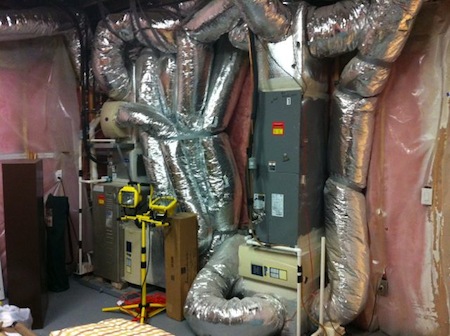
Our understanding now is that it’s generally more important for wall assemblies to be able to dry than it is to block water vapor with materials like polyethylene. Here’s what Bill Rose wrote in his book, Water in Buildings:
“Given the fact that a very small percentage of building problems (1 to 5% at most in the authors experience) are associated with wetting by water vapor diffusion, the argument for enhanced drying potential becomes much stonger.”
Allison A. Bailes III, PhD is a speaker, writer, building science consultant, and the founder of Energy Vanguard in Decatur, Georgia. He has a doctorate in physics and writes the Energy Vanguard Blog. He is also writing a book on building science. You can follow him on Twitter at @EnergyVanguard.
Related Articles
Vapor Retarder? Vapor Barrier? Perms? What the Heck?!
Why Did Painters Refuse to Paint Insulated Houses in the 1930s?
Air Barriers, Vapor Barriers, and Drainage Planes Do Different Jobs
NOTE: Comments are closed.
This Post Has 14 Comments
Comments are closed.

Only $4 million and they got
Only $4 million and they got all that wonderful flex duct AND polyethylene sheeting. What a great deal!
I enjoyed the blog, as always
I enjoyed the blog, as always, and I respect you for staying on topic. However, for me, focusing on the plastic in the last illustration was hard. I got trapped by the ductopus and flex in bondage. It’s almost as impressive as the image you have often used. Surely that many mistakes in one frame are worthy of a separate blog.
And what of builders who use
And what of builders who use poly to seal off each side of a double-stud framed wall to shoot it full of blown cellulose (in NC)? They say they are achieving super-high R values. To me this seems like they are creating the potential for a moisture laden bunch of settled cellulose, but I welcome your comments.
In New England many homes
In New England many homes still use a skim coat of plaster over blueboard. How does this type of surface affect vapor movement on either side of the wall?
A Hyde: Oh
A Hyde: Oh, but you should have seen the sauna, the great room, and the billiards parlor!
Bob K: Good idea! I did write about that house a year ago. It’s one that Martin Holladay and I discovered when he was here in Atlanta: The Energy Nerd’s Tour of Green Homes in Georgia.
Charles: My friend Mike Barcik has a good description for a wall where you put poly on both sides: a terrarium. It’s a stupid idea.
jack: By blueboard, you probably mean extruded polystyrene (XPS). It’s a class II or class III vapor retarder and can work fine, even with plaster on the outside, as long as you allow for moisture that gets behind it to drain away. A drainable housewrap behind the XPS works for that purpose.
Darrel T.: It does indeed look like it could be condensation behind the poly, but it wasn’t. The material is translucent, and that’s what makes it look like it may be fogged up with condensation. I wouldn’t be surprised if it does fog up sometimes, though.
Allison – as an FYI, blue
Allison – as an FYI, blue board in this case is actually a specially coated drywall sheet specifically meant for plaster
Jack – the materials still allow for drying both ways
In mixed humid climates (most
In mixed humid climates (most of eastern US), it’s best to have vapor retarder in middle of the thermal sandwich. This can easily be accomplished with continuous foam boards on the exterior, fibrous insulation on the inside and a couple of layers of inexpensive building felt on the wood sheathing. This also mitigates thermal bridging.
Digressing again to the ducts
Digressing again to the ducts!! So people still like flex duct. The linked 1995 study for EPRI showed that in residential new construction in a dry climate, only two builders out of 10 had appropriate AC airflow for the climate. One of the builders used oversized air handlers to accomplish this (with massive watt draw penalties) and the other used rigid duct. All the rest of the inappropriate airflows were using flex duct (see figure 2-5). Has nothing changed?
what is your take on the
what is your take on the inside in a rain screen wall type in a wet to colder climate?
Although I am a Mechanical
Although I am a Mechanical Engineer, I don’t do residential construction so the understanding in this area wasn’t totally there until reading your article. Thank you for lining out the overall picture of utility of vapor barriers. I came to the same conclusion as you, but like you mentioned at the beginning was quite confused by the dearth of common sense fact based information (there is a huge amount of information, but most of it does not justify their conclusions). It is nice to hear that you and other professionals are coming around to the same conclusion that I came to (although obviously my mind wasn’t made up as to whether or not I had come up with the correct conclusion until now).
I have to say, I live in super-high humidity (South-east Iowa) and have an old house with a basement full of clay dirt/mud which brings in huge amounts of humidity due to the high temperatures in the basement. So this gives me the understanding that I need to control that year round source of moisture from the ground by first redirecting as much moisture away from the basement as possible, AND THEN seal off the ground to the basement environment as good as I can to retard the vapor from getting in there in the first place. Then obviously I need to control the humidity with a dehumidifier so I can apply some polyethylene to the floors of my home. Thanks again!
I purchased a home that’s 130
I purchased a home that’s 130 year old. It has cypress throughout all of the walls. I love the house my only problem is that the walls sweat… The home doesn’t have a basement and it sit on piers off of the ground, can you please advise me what I may do to help with removing the water out of the walls
Vent under the house.Poly 6
Vent under the house.Poly 6 mil. over dirt.Direct roof and ground water away from and around house.Do these first.
Any chance you could help us
Any chance you could help us with our dilemma? Our 1930’s wood-framed brick-veneer house in hot, humid Houston is being gutted and remodeled. We had spray foam insulation (open cell, I recall) sprayed on all walls, the underside of the roof and the underside of the floor in the crawlspace under the house of pier and beam foundation. (NOTE there is one 25’X15′ room that sits on a slab foundation … interestingly, we also have a 10’x12′ basement that filled up with water during Tropical Storm Allison.)
There is no vapor barrier between the brick and the wood framed walls. In fact, the original tar paper against the wood frame is probably rotted away based on what I’ve seen from the spots where we have done brick work in the past. I’m being told that our walls will rot in 20 years if we don’t install a vapor barrier because the spray foam will cause moisture to collect in the wood keeping the wood wet without any proper method of drying out. We didn’t plan on tearing off all the brick to install a vapor barrier, but we don’t want our walls to rot or be fodder for termites. Any chance you have some good advice for us to help keep our home energy efficient, comfortable, and not slowly rotting away? Thanks so much for your help.
Regards,
Rich
do I need to put poly in the
do I need to put poly in the ceiling of a drywalled unheated garage before I blow in insulation?